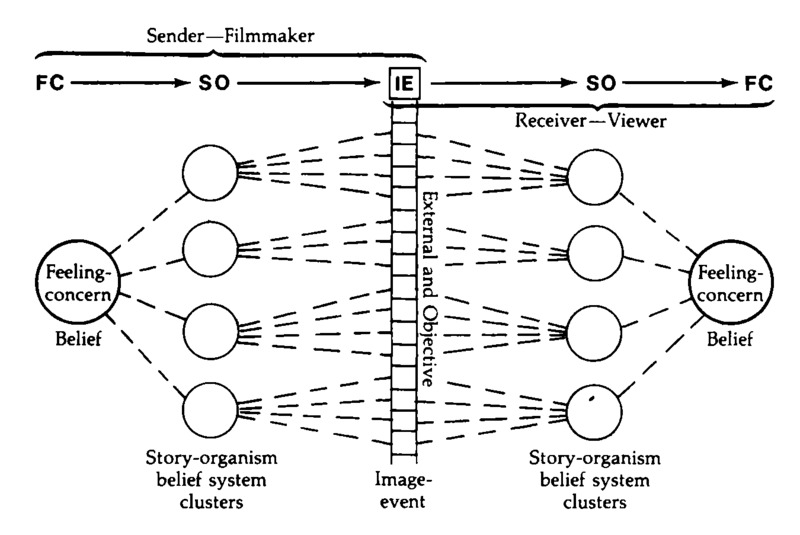-
Title
-
The Process of [Film] Communication—Ideal Model
-
Description
-
We have hypothesized a process that starts with an internalized Feeling-Concern and develops into a more coherent and organized (but sometimes, as in the case of a scriptless film, still internal) Story-Organism, which then controls the choice and organization of the specific Image-Events that are always the external, available film. We have suggested that viewing the film is a mirror image of the making process, that is, that the decoder reverses the process by which the encoder made the film. Should our viewer choose to treat these signs and signals as a message, he will first infer the Story-Organism from the sequenced Image-Events. He will become aware of the belief system of the film-maker from the images he sees on the screen. From this awareness of the message he will, if the communication "works," be able to infer -- to evoke in himself -- the Feeling-Concern.… Let us examine in [the figure] the relationship between the sign system and the participants in its use. The first notion that emerges quite clearly is the difference between the image-event and both the feeling-concern and story-organism.The three terms on the left of the drawing can be thought to belong to the realm of the filmmaker. The three on the right belong to the realm of the viewer. The image-event is the nodal point of the process. It is common to both filmmaker and viewer--to both sender and receiver, creator and re-creator. The image-event is different from the other two terms in that it is part of the process both for the filmmaker and for the viewer.It is also the only unit of this process that is directly observable.The parts of the process that lead to the image-event and those that lead away from it to the inference of meaning on the part of the viewer are internal processes. The strip running down the page (like a strip of film) is our external, objective image-event. The series of concepts across the top of the model describing the process represent our internal world.
-
Designer
-
Worth, Sol
-
Date
-
1968
-
Source
-
"The Development of a Semiotic of Film"
-
Bibliographic Citation
-
Worth, Sol and Larry Gross. 1968 "The Development of a Semiotic of Film." In Studying Visual Communication (1981), by Sol Worth. Edited, with an Introduction, by Larry Gross. University of Pennsylvania Press. Figure 1-1. Pages 43-45.
-
Worth, Sol. 1969. "The Development of a Semiotic of Film." Semiotica, 1:282-321.
-
is composed of
-
English
Circle
-
English
Square
-
has attribute
-
English
Arrow
-
English
Dash Line
-
English
Solid Line
-
use feature
-
English
Brace
-
depict things of type
-
English
Sequence or Process
-
Alternative Title
-
The Process of Communication—Ideal Model
-
Coverage
-
communication
-
film
-
narrative
-
semiotics
 Worth-1.png
Worth-1.png